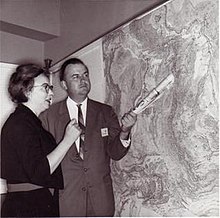Marie Tharp: Difference between revisions
Wording (clarity)- minor changes |
|||
| Line 75: | Line 75: | ||
{{DEFAULTSORT:Tharp, Marie}} |
{{DEFAULTSORT:Tharp, Marie}} |
||
[[Category:University of Michigan alumni]] |
[[Category:University of Michigan alumni]] |
||
[[Category:University of Tulsa alumni]] |
|||
[[Category:American cartographers]] |
[[Category:American cartographers]] |
||
[[Category:American geologists]] |
[[Category:American geologists]] |
||
Revision as of 16:16, 18 June 2014
Marie Tharp | |
|---|---|
 Tharp and Bruce Heezen | |
| Born | July 30, 1920 |
| Died | August 23, 2006 (aged 86) |
| Nationality | United States |
| Citizenship | United States |
| Alma mater | Ohio University University of Michigan University of Tulsa |
| Known for | Seafloor topography |
| Scientific career | |
| Fields | Geology, Oceanography |
| Institutions | Lamont-Doherty Earth Observatory |
Marie Tharp (July 30, 1920 - August 23, 2006) was an American geologist and oceanographic cartographer who, in partnership with Bruce Heezen, created the first scientific map of the entire ocean floor. Tharp's work revealed the presence of the Mid-Atlantic Ridge and revolutionized scientific understanding of continental drift.
Life and career
Tharp was born in Ypsilanti, Michigan. Her father, William, made soil classification maps for the U.S. Department of Agriculture. Her mother, Bertha, was an instructor in German and Latin.
Tharp graduated from Ohio University in 1943 with bachelor's degrees in English and music and four minors. She later received a master's degree in geology from the University of Michigan before earning a degree in mathematics from the University of Tulsa while working as a geologist for the Stanolind Oil company.[1]
Moving to New York in 1948, Tharp was employed by Maurice Ewing at the Lamont Geological Laboratory (now the Lamont-Doherty Earth Observatory) at Columbia University, initially as a general drafter.[1] There Tharp met Heezen and in early work together used photographic data to locate downed aircraft from World War II.[2] Later, they began working together to map the topography of the ocean floor. For the first 18 years of their collaboration, Heezen collected data aboard the Observatory's ship, the Vema, and Tharp drew maps from that data, since women at that time still were excluded from working aboard ship. Restricted from conducting research at sea early in her career due to her gender, she later was able to join a 1965 data-collection expedition. Tharp independently used data collected from the Woods Hole Oceanographic Institution's research ship Atlantis, and seismographic data from undersea earthquakes. Her work with Heezen represented the first systematic attempt to map the entire ocean floor.
Tharp and Heezen published their first physiographic map of the North Atlantic in 1957. Collaborating with the Austrian landscape painter Heinrich Berann, they published their map of the entire ocean floor in 1977 (coincidentally, also the year of Heezen's death). Although for a time he favored the expanding Earth hypothesis,[3][4] under Tharp's direction he turned to the alternative theories of plate tectonics and continental drift.
Tharp continued to serve on the faculty of Columbia University until 1983, after which she operated a map-distribution business in South Nyack, New York during her retirement.
Tharp died of cancer in Nyack, New York on August 23, 2006.[5]
References
- ^ a b Tharp, M. (2006-12-12). "Marie Tharp biography". Woods Hole Oceanographic Institution. Retrieved 2008-06-02.
- ^ Evans, R. (November 2002). "Plumbing Depths to Reach New Heights". Retrieved 2008-06-02.
- ^ Barton, C. (2002). "Marie Tharp, oceanographic cartographer, and her contributions to the revolution in the Earth sciences". Geological Society, London, Special Publications. 192 (1): 215–228. doi:10.1144/GSL.SP.2002.192.01.11.
- ^ Doel, R.E. (2006). "Extending modern cartography to the ocean depths: military patronage, Cold War priorities, and the Heezen-Tharp mapping project, 1952-1959". Journal of Historical Geography. 32 (3): 605–626. doi:10.1016/j.jhg.2005.10.011.
{{cite journal}}: Unknown parameter|coauthors=ignored (|author=suggested) (help) - ^ Fox, Margalit (August 26, 2006). "Marie Tharp, Oceanographic Cartographer, Dies at 86". New York Times. Retrieved April 9, 2012.
- C250 Celebrates 250 Columbians Ahead of Their Time: Entry on Marie Tharp.
- Woods Hole Oceeanographic Institution. "Marie Tharp Honored at Women Pioneers Seminar."
- The Earth Institute at Columbia University. "Mapping Methodology Examples (North Atlantic)."
- The Earth Institute at Columbia University. "Marie Tharp, Pioneering Mapmaker of the Ocean Floor, Dies." Earth Institute News, August 23, 2006.
- Nelson, Valerie. "Marie Tharp, 86; Pioneering Maps Altered Views on Seafloor Geology." The Los Angeles Times, September 4, 2006.
- Hall, Stephen S. "The Contrary Map Maker" The New York Times Magazine, December 31, 2006.
Further reading
- Doel, Ronald (1970–1980). "Tharp, Marie". Dictionary of Scientific Biography. Vol. 25. New York: Charles Scribner's Sons. pp. 29–31. ISBN 978-0-684-10114-9.
External links
- Marie Tharp Maps
- Soundings: The Story of the Remarkable Woman Who Mapped the Ocean Floor by Hali Felt
- Marie Tharp at Columbia University
